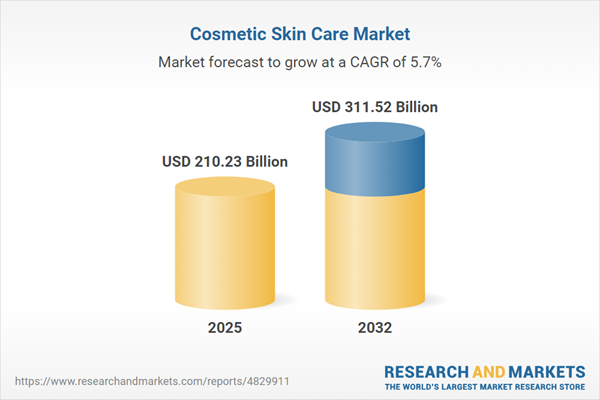Speak directly to the analyst to clarify any post sales queries you may have.
The cosmetic skin care market is experiencing a notable shift as organizations adapt to consumer-centric models and digital-first business strategies. New digital innovation, regulatory pressures, and sustainability expectations are reshaping priorities and creating opportunities for proactive industry leaders determined to grow across regions.
Market Snapshot: Cosmetic Skin Care Market Growth Trajectory
Growth within the cosmetic skin care market is strong, supported by rising demand for product transparency and highly individualized solutions. Companies are transforming organizational structures through digital adoption, embedding next-generation technologies to remain agile and responsive. Market momentum also benefits from robust navigation of regulatory complexity and evolving, region-specific channel strategies. Executives now invest heavily in omnichannel approaches and operational flexibility, positioning their businesses to adapt quickly to consumer trends and compliance requirements in diverse markets.
Scope & Segmentation of the Cosmetic Skin Care Market
- Product Types: Anti-aging solutions, facial cleansers, eye and body care, exfoliating scrubs, conditioning serums, hydrating lotions, treatment masks, sun protection, and toners enable tailored answers to everyday and specialized skin care needs.
- Skin Types: Formulations for combination, sensitive, dry, oily, and normal skin help brands target specific demographics and respond to nuanced geographic demands.
- Packaging Formats: Bottles, jars, tubes, and sachets, often made with recyclable or biodegradable materials, address growing pressure for environmental stewardship and regulatory compliance.
- Application Areas: Solutions focusing on hydration, brightening, acne care, anti-aging, and sun defense are developed to align with evolving wellness objectives and distinct user priorities.
- Consumer Types: Offerings designed for both individual customers and professional settings, such as clinics and spas, expand engagement points and build strategic opportunities for both suppliers and brands.
- Gender Segments: Specific product lines for women and men, including expansions in male-focused formulations and marketing, reflect changing patterns in consumer engagement.
- Age Groups: Product portfolios covering teenagers, adults, and the senior population enable brands to foster long-term loyalty through cycle-oriented solutions and age-specific messaging.
- Distribution Channels: Department stores, supermarkets, pharmacies, online platforms, and third-party retailers serve the diverse buying preferences and regulatory backgrounds in each region.
- Regions & Key Geographies: Local adaptation and nuanced strategies are essential in the Americas, Europe, Asia-Pacific, and the Middle East & Africa, due to distinct regulatory frameworks and consumption patterns.
- Key Companies: Multinational enterprises such as L'Oréal S.A., Unilever PLC, Avon Products, Colgate-Palmolive Company, The Estée Lauder Companies, and Shiseido, as well as agile regional competitors, shape ongoing market direction.
- Innovative Technologies: Advanced platforms including AI diagnostics, augmented reality, blockchain-based supply chain transparency, and integrated digital workflows enhance brand credibility and consumer interaction.
Key Takeaways for Senior Decision-Makers
- Shorten research and product validation cycles to build trust and maintain relevance within advanced trends in cosmetic skin care.
- Pursue sustainable packaging and prioritize ethical sourcing to address compliance and demonstrate broader corporate responsibility.
- Adopt AI-driven diagnostics and immersive technologies to deepen consumer engagement and optimize digital sales interactions.
- Diversify across female, male, youth, and senior segments by providing targeted benefits and fostering life-stage loyalty.
- Strengthen regional supply and logistics networks for better agility in responding to dynamic regulatory changes and market scaling.
Tariff Impact: Navigating 2025’s Regulatory and Cost Landscape
- Implement local sourcing and vertical integration to minimize risk from tariff instability and support adherence to local regulations.
- Transition to lighter, refillable, and locally made packaging to increase efficiency and meet evolving sustainability standards.
- Optimize logistics frameworks for consistent supply access and quick adaptation to new compliance mandates within target regions.
Research Methodology & Data Sources
This analysis relies on executive-level interviews and insights from technical experts in the sector, cross-validated with independent market data and regulatory reviews. The methodology ensures that every recommendation is matched to current industry realities and strategic planning needs.
Why This Report Matters
- Supports informed strategic growth and risk planning in the dynamic cosmetic skin care landscape.
- Clarifies how digital transformation and regulation are impacting operations, resource alignment, and executive priorities.
- Guides organizational adaptation toward agile, resilient models that can compete in this sector.
Conclusion
Companies that prioritize digital advancement and agile regulatory strategies will reinforce organizational resilience and position their skin care businesses for sustained, competitive growth in a changing market.
Additional Product Information:
- Purchase of this report includes 1 year online access with quarterly updates.
- This report can be updated on request. Please contact our Customer Experience team using the Ask a Question widget on our website.
Table of Contents
3. Executive Summary
4. Market Overview
7. Cumulative Impact of Artificial Intelligence 2025
Companies Mentioned
The companies profiled in this Cosmetic Skin Care market report include:- L'Oréal S.A.
- Unilever PLC
- A One Cosmetics Products
- Amorepacific Corporation
- Avon Products, Inc.
- Beiersdorf AG
- Bo International
- CHANEL Ltd.
- Colgate-Palmolive Company
- Coty Inc.
- Eminence Organic Skin Care
- ESPA International by The Hut Group
- Galderma S.A.
- Gayatri Herbals Pvt. Ltd.
- Henkel AG & Co. KGaA
- Himalaya Wellness Company
- Honasa Consumer Ltd.
- JAFRA Cosmetics International, Inc. (Betterware de México, S.A.P.I. de C.V.)
- Johnson & Johnson Services, Inc.
- Kao Corporation
- Natura & Co Group
- Oriflame Cosmetics AG
- Plum
- Procter & Gamble Company
- Revlon, Inc.
- Sarvotham Care
- Shiseido Company, Limited
- The Estee Lauder Companies Inc.
- The Goodkind Co. by Phlur
- Yves Rocher S.A.
Table Information
| Report Attribute | Details |
|---|---|
| No. of Pages | 196 |
| Published | October 2025 |
| Forecast Period | 2025 - 2032 |
| Estimated Market Value ( USD | $ 210.23 Billion |
| Forecasted Market Value ( USD | $ 311.52 Billion |
| Compound Annual Growth Rate | 5.7% |
| Regions Covered | Global |
| No. of Companies Mentioned | 31 |









